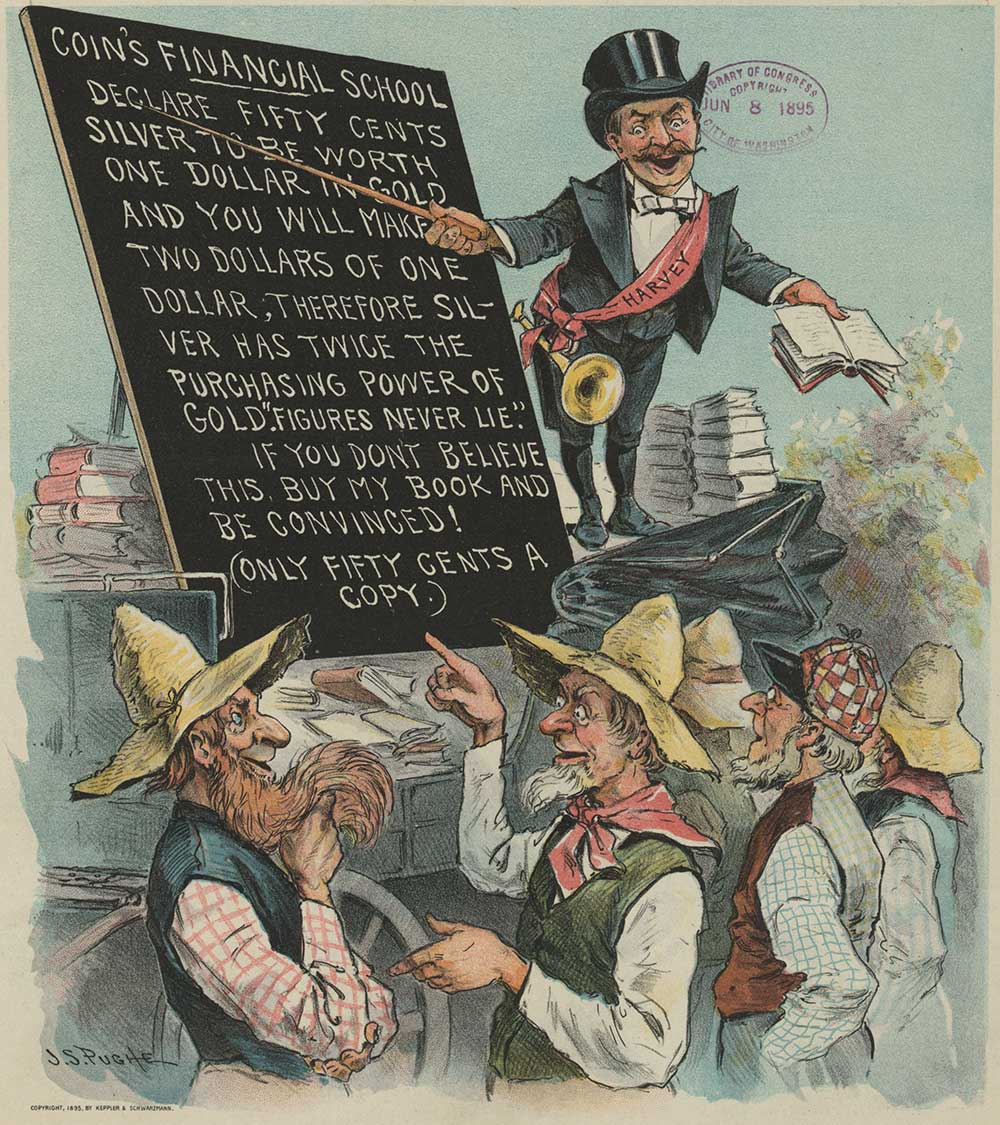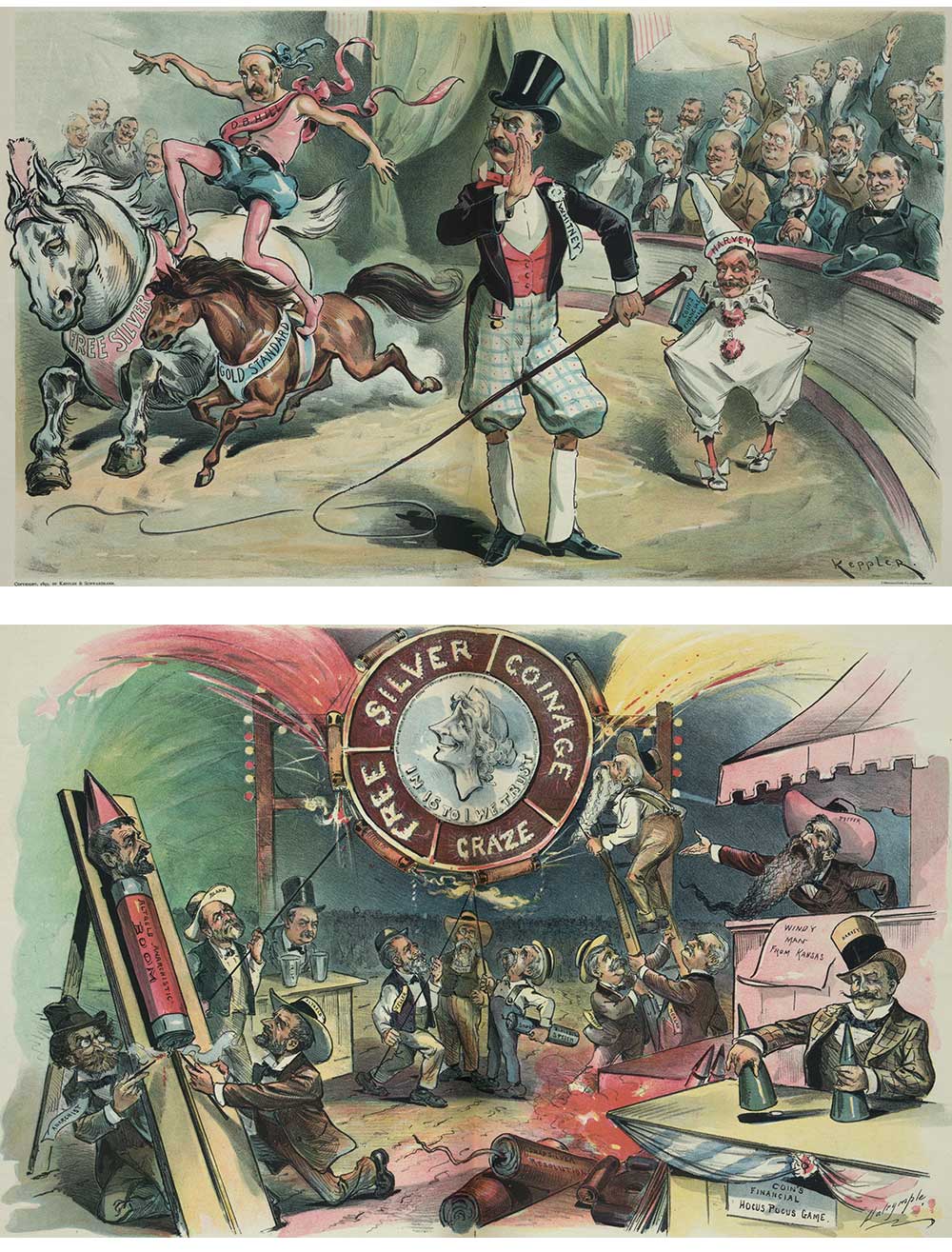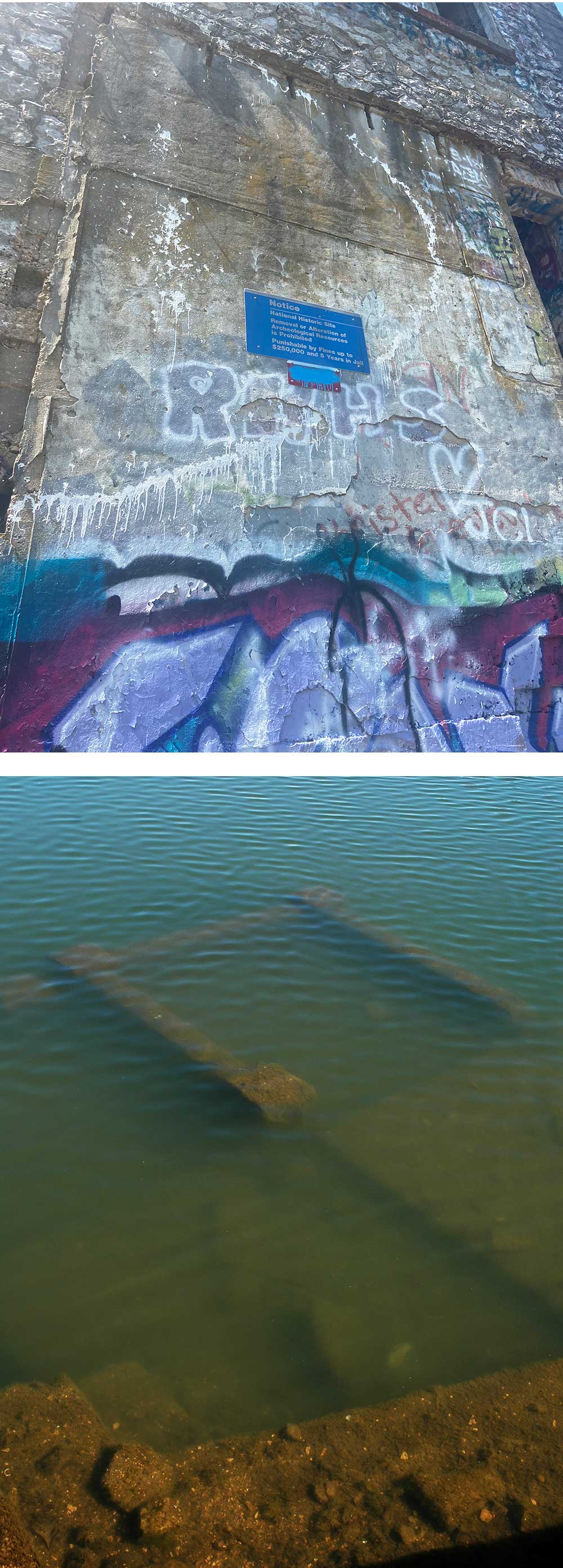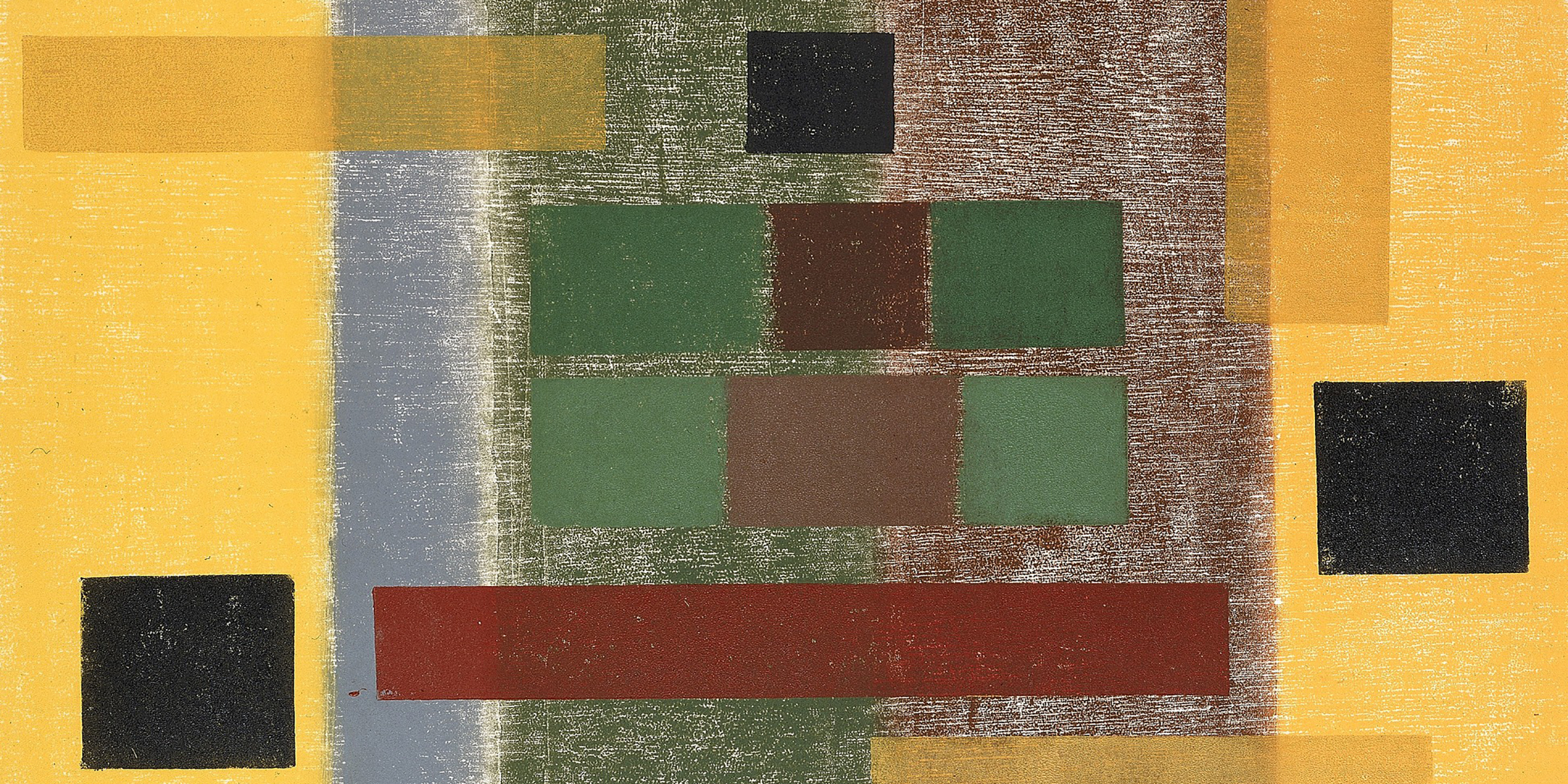In 1926 William Hope “Coin” Harvey began constructing a “pyramid” in the Arkansas Ozarks, with the intention of single-handedly preserving a record of the dying American civilization’s proudest creations in a concrete time capsule. Less than fifty years later, the remains of his monument—more of an obelisk than a pyramid—was eroding under the surface of a man-made lake. The remains of Harvey lie in a mausoleum nearby; they, too, would be drowned had they not been moved further up the bank of Beaver Lake by a local contractor at the behest of the U.S. Army Corps of Engineers. The futility of Harvey’s final work echoes the fruitlessness of the project for which he was most known: bimetallism and the return of free silver, a monetary system based on silver as well as gold.
Harvey was many things: a lawyer, a businessman, a mine owner, a real estate developer. But at his core he was a political thinker whose pamphlets reached hundreds of thousands, if not millions, of readers during the late nineteenth-century fight over fiat currency. He was a visionary, a crank, a failure, a polemicist who thought of himself as a prophet. His commitment to a political ideology that a century later has fallen almost entirely out of public consciousness pulled him away from his responsibilities to his family and his business ventures; now he is all but unknown.
Born in Virginia in 1851, Harvey was practicing law in West Virginia by the age of twenty. He moved to Gallipolis, Ohio, a few years later and began a restless and elusive search for a home and purpose. He met his wife Anna there in 1875, and he spent their life together making clear that he did not consider her part of that home or purpose. The family moved to Cleveland, then Chicago, and back to Gallipolis before Harvey moved his wife and children to Colorado, where he would become the superintendent of production at a silver mine. It was the 1880s, and silver’s value was falling. The supply had exploded due to new silver mines in the American West, just as various European states—and the United States itself—had moved away from silver coinage in the previous decade. If this was the genesis of Harvey’s allegiance to free silver, it was a hard lesson indeed. Harvey turned from mining to real estate in the West, buying land, building houses, and promoting festivals with some success and at least one catastrophic failure before moving the family back to Chicago in 1893 with what he claimed “was then a considerable fortune.” It was here that his political career and the project for which he would be known for the rest of his life began in earnest.
Harvey founded a publishing company devoted to free silver in Chicago and was soon releasing his own works on the subject. In 1894 he wrote Coin’s Financial School, a compilation of lectures given by a fictional sixteen-year-old boy named Coin (a nickname by which Harvey thereafter was known) in favor of bimetallism and free silver. Harvey’s economic theories were self-taught, drawing on a major political movement that sprang up in part due to silver’s decline amid several economic panics. As pointed out by interlocutors at the time, they were also overly simplistic, which wasn’t necessarily a detraction for his many readers. His prose was clear and convincing, spelling out the complicated economic debates dominating political conversations of the time while naming and indicting the systems and people he saw as responsible for silver’s demonetization. The book sold at least 650,000 copies according to a conservative estimate from historian Richard Hofstadter, who dubbed Harvey “the Tom Paine of the free-silver movement.” The lifetime sales of Coin’s Financial School were probably closer to one million copies. It was hawked by newsboys on railroad trains, sold at cigar stores, and distributed by the National Silver Party and other pro-silver organizations. Its enormous impact and popularity was a reflection of the political climate of the age and the sentiments of a rural white farming class convinced that its interests were being trodden on by banking elites and businessmen—and that only government intervention could provide an answer.

Harvey was not humble about such success. An autobiography dictated to his son near the end of his life characterizes Coin’s Financial School as “the Bible’s only rival for big sales. Throughout the West and the South he was hailed as ‘Our Savior.’ His followers numbered millions.”
The Free Silver Movement sputtered out around the turn of the century, though for Harvey the cause of free silver and the economic oppression of the common man would be a lifelong passion. His idealism kept him out of mainstream politics after 1898, however.
The fundamental problem Coin confronted—the existential query at the heart of economic discourse of the time—concerned the character of money. Who produces it, what is it based on, and who determines its value? The question of money gained salience for lower- and middle-class Americans after the Civil War, when the Greenback Party—a short-lived agrarian antimonopoly party—advocated against the gold standard and for a paper money system; the Populist movement of the late nineteenth century carried on the democratic, antimonopoly cause in rural farming communities around the country after the Greenbackers’ last electoral attempt in 1889. Harvey brought the Populist cause to the city, taking on—if only fictionally—the bankers, politicians, and newspapermen he believed to be conspiring against the poor, the producers, and the farmers. He was not alone: free silver was a truly popular movement. During the Civil War, the federal government had for the first time issued money backed not by gold but by government bonds. After the war, when the U.S. moved back to a metal standard, leading to deflation, Greenbackers pushed for unbacked currency to remain in circulation. Free silverites and bimetallists wanted the same sort of inflationary policies by including silver in the specie standard. For Americans outside city centers, concentration of wealth, capital, and political influence in the hands of banks and monopolies rang unfair, especially while farmers were trapped in a cycle of debt from which it seemed nearly impossible to emerge.
Harvey continued to develop and propagate his political philosophy through his publishing company, releasing other books of fictional Coin lectures on bimetallism, including 1895’s Coin’s Financial School Up to Date and at least one other book by another proponent of bimetallism. Another Harvey book, The Patriots of America, proposed the formation of a new fraternal order that would protect the United States from “foreign influences,” by which he mostly meant the British. In another Coin volume, titled Coin on Money, Trusts, and Imperialism, Harvey’s alter ego plays the democratic theorist as well as the free-silver advocate. “Individual selfishness crystallized into the laws of nations is the cause of the overthrow of republics, and is the mother of monarchies,” Coin argued. His primary villains were banks, bankers, and the nation of England, whose monetary policies he believed were bleeding the United States dry. Harvey envisioned a monetary system unbound from the supremacy of London, Chicago, and New York. Like many other Populists, he trafficked in anti-Semitism, implicitly and often explicitly in the cartoons that accompanied his books. His prejudice is especially apparent in his novel, A Tale of Two Nations, published the same year as Coin’s Financial School, which included a fictionalized version of the Rothschild family and a villain clearly coded as Jewish.

The popularity of Harvey’s books and the prominence of the free-silver issue among the Populists that the Democratic Party needed to keep in its fold led him into political activism in Chicago. He was the chairman of the Democratic National Committee’s Ways and Means Committee in the 1890s and campaigned for William Jennings Bryan in the 1896 election. The longer Harvey wrote and engaged in politics around Populism, an economy that worked for the common (white) man, and free silver, the more of a true believer he became. “Our cause is a religion!” Coin cries in Money, Trusts, and Imperialism. Harvey’s cause was a life force, and it was perhaps too much for the politicians he worked with. According to the autobiography dictated to his son and a separate biography written by his daughter, it was his idealism and a falling-out with Bryan that led to the move to the Ozarks.
“One man among all of his disappointments was William Jennings Bryan,” wrote Harvey’s daughter Mary.
Bryan’s intelligent grasp, his magnetic personality, his rise to prominence and ultimate three-hour “cross of gold” speech, caused father to believe that this man should be president of the United States for the benefit of the entire nation. Then the time came when the zeal of two crusaders diverged. The fluent Bryan’s lectures were in demand, he took a world tour, other subjects than bimetallism and economic maladjustments found greater favor with his audiences—Darwinism…the Bible and Its Enemies—Bryan’s earnings were enormous, his life luxurious. He repudiated early vows; and in grief father retired to the Ozark Mountain in northwest Arkansas.
Harvey was a dramatic figure, so it seems wise to consider the family retelling of this move with skepticism. Exclusion from Democratic Party politics, money problems, family issues, and the restlessness that had led him to live lives in so many different places prior to settling in Chicago probably all played a role in the decision. But the trajectory of Harvey’s life after his move indicates we should take his stated reasons seriously as well. Harvey believed that he alone had discovered the political path that would save America, and that the Democrats, with their failure to accept his vision, were complicit in consigning American civilization to ruin.
Harvey’s move to Silver Springs, Arkansas—which he renamed Monte Ne, allegedly (though not in fact) a combination of the Omaha Indian and Spanish words for “Mountain Water”—also marked a return to the entrepreneurial spirit that had marked his pre-political life. The location, he said in his autobiography, was chosen because it was “the most beautiful spot in the world” and its water “the purest.” The lack of wealthy individuals or large cities in the surrounding area played a part in his decision as well. The resort town that Harvey built up around Monte Ne included a bank, a railroad spur, several hotel log cabins, an amphitheater, and a pool. Construction was not without its difficulties. A strike by local workers hired to build part of the resort was in particular a source of consternation for Harvey.
As Harvey obsessed over Monte Ne and his ideology, his relationship with his wife and children—especially his daughters—foundered. Following a fire that destroyed the house Harvey built at Monte Ne, along with most of the family’s possessions, Anna and many of their children moved back to Chicago, leaving two sons in Monte Ne. It was not the first time he and Anna had lived separately.
At one point, when the fortunes of Monte Ne were dire and after receiving a letter from one of his daughters asking about the state of her parents’ relationship, Harvey admitted that they had not “lived together as husband and wife” for nearly a decade. He blamed it on irreconcilable differences over money and what makes a home. “Had I found in a wife what I wanted and a home which I craved, I would have lavished money on it,” he wrote in his reply. That money, he continued, had instead been spent on the various business and political ventures that had preoccupied his life—on “educating the people.” He was also aware of the reputation his polemical activities had given him in the family: “Your mother, over our differences, had long referred to me as a crank, and you girls got the same idea.”
In a letter to Harvey, Anna threw his own political commitments back at him.
Please read your Patriots of America page 26–27 and see if it may not be applied to you in reference to your family. Are you sure that we have been considered your equals and that our just rights have been granted when they in any instance interfered with not your rights—but simply your desires and inclinations?
In other words, he was a hypocrite who welcomed political debate only when it didn’t involve the well-armed intellects waiting at home. “If your office is not self-supporting, in that I mean bringing in enough for a plain living for your family and necessary office expenses,” she continued, “by all the laws of the land turn off your help and get cheaper.” Anna and Harvey divorced in 1929. Harvey married his secretary at Monte Ne later the same year.
At Monte Ne, Harvey “wanted to act as host for the greatest philosophers of our time,” his dictated autobiography reads. “He wanted them to evolve a practical philosophy to help the people.” It’s not clear the extent to which his vision was realized, but Harvey continued churning out political pamphlets, including a monthly newspaper called The Liberty Bell. This was the voice of a political party also founded by Harvey, the Liberty Party, for which he stood as a candidate for president in 1932 at the age of eighty. He finished in sixth place with 53,000 votes, just over a thousand of them from Arkansas and only two—likely those of Harvey and his wife—from Rogers, the city closest to Monte Ne.
Yet even as he continued to participate in popular politics, Harvey became more and more certain that the selfishness and greed in American business and political life—and the country’s failure to heed his warnings—were leading to its rapid downfall. For this reason, he decided to build what he called a “great pyramid,” the construction of which was announced in 1920. The structure would tower high enough that it would not be covered by shifting sands and eroding earth over the ages. It was designed to be large enough to fit “all the discoveries made in this civilization, such as the airplane, automobile, explosives, etc. etc. so that the next civilization will not have to be troubled with rediscovering them” in its base. Harvey claimed that engineers had assured him the concrete edifice would last for ten million years.
Inside the obelisk, in addition to the various inventions Harvey planned to include for the convenience of civilizations to come, would be a telling object. “In the center of the Pyramid, on a pedestal, there shall rest a copy of the book by Harvey, printed on specially treated paper and sealed in an airtight glass cylinder. This book tells why through selfishness and greed our country was monopolized by 5 percent of the population, while the rest of the people stole, murdered, starved, fought, lost free speech,” and fought an apparently still-to-come civil war. The book (now largely unavailable) described the failings of a civilization whose economy was based on what he called “usury”—by which he meant the charge of interest. “Trusts, monopolies, and combinations are fleecing the people, fixing the prices low for the producer and high to the consumer—thus forcing people to mortgage and bond themselves to keep civilization functioning,” he wrote.
The pyramid was the last gasp of the wisdom Harvey had hoped to share with the world—which, not having taken root in his own time, he believed would bear fruit for other societies on the road to modernism. Free silver was all but dead, and Populism with it. His compatriot Bryan’s stint as Woodrow Wilson’s secretary of state had ended with Bryan’s refusal to bring the United States into World War I. He abandoned free silver, instead taking up the cause of evangelicalism, most famously as part of the Scopes Monkey Trial.

Harvey never raised the funding for his pyramid. Nothing except the base was constructed, despite several hundred tons of concrete donated by the Portland Cement Association. His most lasting contribution to the Arkansas Ozarks was the Ozark Trail Association, which constructed the beginnings of a highway system in the area. Harvey hoped these highways would bring more traffic to his resort; this expectation, like so many of his others, never materialized. His preoccupation with politics and the monument accompanied a decline in the fortunes of the Monte Ne resort, which was eventually closed and sold. He died in 1936, his second wife at his bedside.
Thirty years later, the Army Corps of Engineers constructed a dam on the White River, creating Beaver Lake, a recreational spot that also provides drinking water to surrounding towns. The Monte Ne resort was largely dismantled in preparation for the flooding. The log cabins were moved down the road and Harvey’s tomb moved up the bank, leaving the amphitheater, a few concrete buildings, and the base of the pyramid behind. The lake flooded the town of Monte Ne, enveloping the ruins of Harvey’s resort and the plinth of the monument that he had once hoped would stretch so high it would outlast any thinkable environmental calamity. Now, unless the river is unusually low, the only visible part of Harvey’s legacy is a single concrete tower of the resort, ensconced in a barbed-wire-topped chain-link fence with a broken gate covered in graffiti. His books are out of print, his political project largely dead, and even in a country still facing an economy plagued by monopolies, big banks, and ever-increasing wealth inequality, nobody thinks of Coin Harvey when they consider who could save it.
